I’m back in Port Moresby. Everyone has left the boat, so it’s quiet time for a day. I have yet to pack, which means I’m looking for ways to procrastinate.
Got up early this morning. Not sure why, given the lack of immediate pressure to get anything done. I’ve had three cups of coffee so far, sorted out a handful of logistical issues, and scarfed down more cookies than I probably should have.
Outside, the winds are howling…running a continuous 30 to 35 knots, exceeding that every now and then, while pelting rain adds a bit of excitement from time to time. A nearby boat apparently sank last night. The few trees that line the harbour’s edge, short ones with sparse foliage, are doubled over, appearing as if they’ve been sucker-punched by Mother Nature.
We were forced back to the coast earlier than scheduled, which is unfortunate, but all-in-all, the past few weeks of diving in the Eastern Fields of Papua New Guinea has been awesome. The water was clear; marine life plentiful; and until the winds and swells picked up a few days ago, the weather ideal.
This being my fifth trip to the Eastern Fields (spanning about 16 weeks since 2004), you’d think I might have grown tired of diving the area. Not a chance.
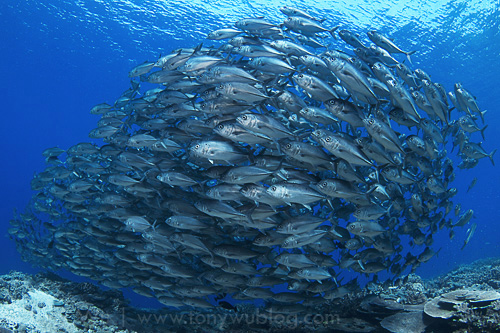
Large school of bigeye jacks (Caranx sexfasciatus)
The Eastern Fields is a submerged atoll comprising around 150 square nautical miles. That’s really big. Actually…really, really big. It means the extinct volcano that spawned the atoll was enormous, almost beyond comprehension.
The reefs are about as close to perfect as you can get, given the realities of modern-day pressures like shipping traffic, commercial fishing (especially shark finning!), and marine pollution. This remote atoll and associated reefs have some of the best dive sites in the world, including one site that is the most action-packed reef dive I’ve ever experienced. And despite the fact that Captain Craig has been visiting the area every year since 1992, there are still many parts of the Eastern Fields he’s never dived. In fact, we explored and named four new sites over the past few weeks.
In short, the Eastern Fields is a magical place, which is why I keep going back, and will continue to do so as long as I’m able.
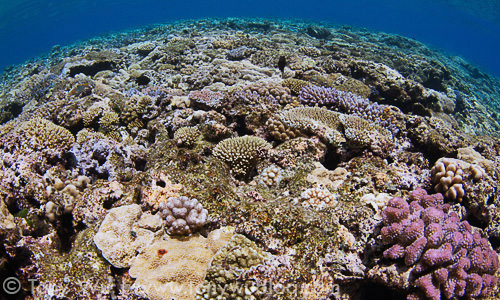
This is a pristine reef top: a profusion of coral in two metres of water.
Diving Carl’s Ultimate
As Craig tells the story, the first time he took my friend and mentor Carl Roessler to this reef, Carl was so amazed that he asked Craig to name the site after him.
The first time I went in, I understood why.
The site is small. Small enough to swim around in 10 to 15 minutes if there’s no current working against you. Small enough to swim over in much less time.
What the site lacks in size, however, it makes up for in action.
The best way to describe what Carl’s is like, is perhaps to allude to the story of Goldilocks and the Three Bears. Just like the perfect porridge in that tale, Carl’s Ultimate is the perfect reef.
It’s located in the perfect spot with the perfect shape, size and orientation, so that currents are neither too strong, nor too weak, and hit at precisely the right angles during both incoming and outgoing tides to make it a happy place to be for fish and other marine life.
When the currents are running at Carl’s, there are, as many have put it: “More fish than water,” ranging from tiny ones like damsels and basslets to impressive dogtooth tunas, trevallies, barracudas, groupers, reef sharks and even a large hammerhead on this trip.
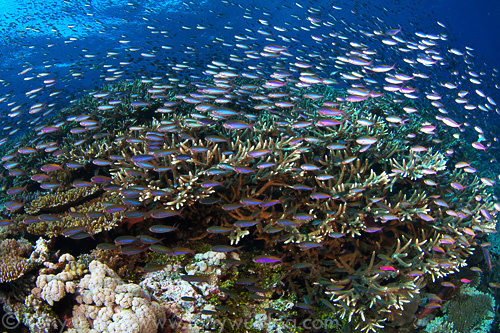
Thousands of fusilier damsels and magenta slender Anthias
swarming over staghorn coral at Carl's Ultimate dive site
On normal charters, Craig only spends a day or so at this site, as most people want to travel around and dive multiple locations across the atoll. While I certainly understand why visitors want to see a broad sampling of what the Eastern Fields has to offer, I’d be perfectly content to sit at Carl’s for an extended period of time, doing two, maybe three, long dives a day timed to coincide with peak currents, and hence peak action.
In fact, that’s exactly what we did on the second of the two recent itineraries. After leaving port, we went straight to Carl’s and stayed for four days. The tides were exceptionally long and strong, meaning peak fish time was jaw-dropping crazy.
When Craig and I planned the dates for this itinerary at the end of 2009, we consulted forward schedules for moon phases and tidal flow, picking dates specifically for this reason. Who knew the two of us could actually get something right?
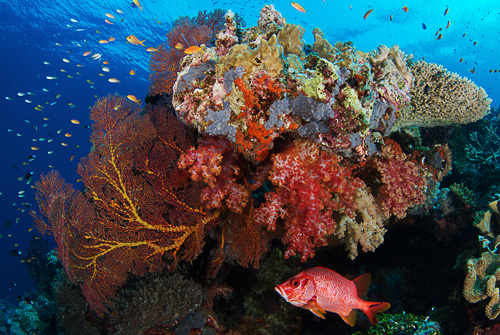
Carl's Ultimate dive site: Hard corals, soft corals, sea fans, sponges, swarming fish
...even an inquisitive squirrelfish (Sargocentron spiniferum)
The action at this site is so dramatic that I can’t recall ever having taken a macro lens down before, but I did this time. Craig performed his excited-little-girl-who-ate-too-many-sugar-cookies impersonation and said he wanted to show me a “really pretty” fish. Sceptical though I was, I had no choice but to humour him; it’s the only way to settle Craig down.
He showed me a colony of Pseudanthias lori, which were down relatively deep (33m or so), swimming upside down, at an odd angle, in erratic fashion, at high speed over a wide area, beneath a ledge that obscured nearly all available light. In other words...perfect conditions for photography (not).
With the aid of a rebreather, I was able to stay down for an extended period to get a few images, which only made Craig more giggly when I showed him. I should’ve known better.
This is one of several male Pseudanthias lori individuals in the colony:

Beautiful Pseudanthias lori basslet at 33m, Carl's Ultimate dive site
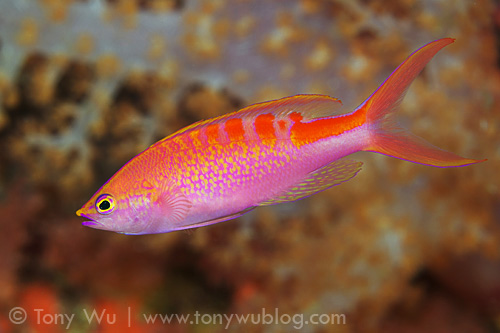
Same fish, different angle, just as spectacular
To give credit where credit is due, Craig certainly has an eye for cute, colour-coordinated fish (with a particular penchant for pink).
Exploration and Discovery
As I mentioned above, we dived, explored and named four new dive sites during the trip: Xanadu, Soi 16, Jellybean Corners, and Silk Road.
Xanadu is a small passage Craig had never noticed before. The outer wall is gorgeous, with corals covering the entire reef, and lots of fish swarming about. The passage from the outside to the interior of the atoll was healthy as well, with troops of multi-hued parrotfish milling about, pooping streams of newly manufactured white sand here and there. During our second visit to this magical place, several co-adventurers came across mating white tip reef sharks. I named the site Xanadu in recognition of its unspoiled condition, and in keeping with Craig’s Asia-themed nomenclature for the sites in this area.
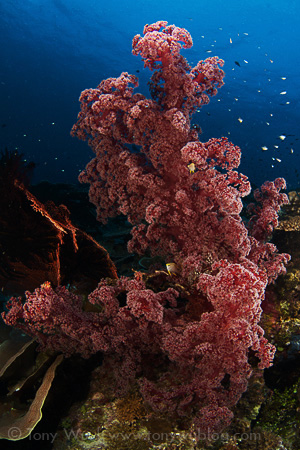
Strawberry-red soft coral at Xanadu dive site
Soi 16 is a submerged barrier reef near Emmmo. The terrain comprises a series of bunkers or “hills”, for lack of a better term, interlaced with channels and cut-out areas. The hills are covered(!) with corals, both hard and soft, and there are tonnes of fish swarming above…fusiliers, jacks, surgeonfish (the largest school I think I’ve ever seen), trevallies, etc. There was so much fish traffic in the area that diving the site reminded me of standing on a street corner in Bangkok. It was the 16th of January, so we called it Soi 16.
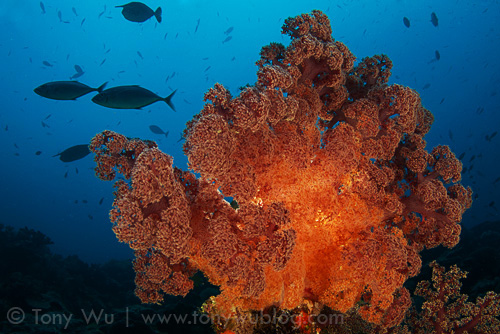
Soft coral and fish at Soi 16 dive site
Jellybean Corners is also at an opening in the atoll, where the outside walls rounds off into two nice corners at opposite sides of the passage opening. When I first dropped in, a gang of adorable baby grey reef sharks paddled in say hello, at least ten of them, perhaps as many as 20.
Though there wasn’t much current when we went there, I’m pretty certain the site gets hit with significant water flow, as there is a profusion of large, multicoloured soft corals on both corners. The brilliant yellows, reds, oranges and pinks of the plush soft corals reminded me of jellybean flavours, hence the name we assigned the site.
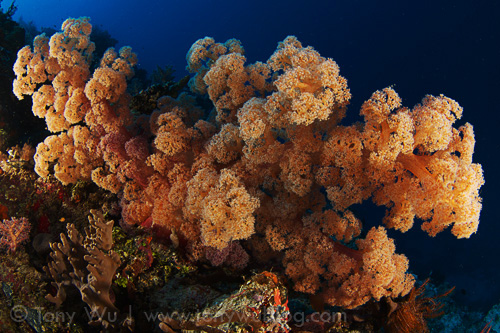
Colourful soft corals like this abound at Jellybean Corners
Finally, we dived and named another small passage in the same general area as Xanadu. Once again, it’s a passage Craig has probably passed many times, but hadn’t noticed. (It would perhaps be appropriate to insert a snide remark about Craig’s power of observation here, but I guess I shouldn’t do that to him, should I?)
Near this passage, the wall folds in and out in an S-curve pattern, covered wall-to-wall with a profusion of corals, mostly hard structures, but also some fans and soft corals closer to the actual passage opening. I gave this site the name Silk Road, in reference to the meandering pattern of the reef, and to go along with nearby site names Mantchuria, Great Wall of China, and Xanadu.
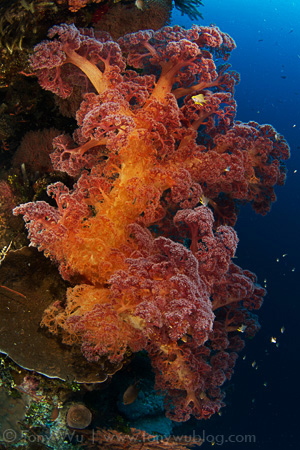
Soft coral at Silk Road dive site
It’s amazing to think that after 20 years of diving in the Eastern Fields, Craig is still finding new sites. The possibility of being the first person to explore a section of the reef is an incredible feeling, something I hope to experience again in the future.
Silly Sallie Story
A trip aboard MV Golden Dawn wouldn’t be complete without a silly story of course, preferably at the expense of my good friend Captain Craig. You would think that after all these years, Craig would’ve learned to be on guard when I’m around. To some extent, he has, but his (futile) efforts to foil my schemes just make it more fun to pull pranks on him.
Sallie’s whale shark encounter is a perfect example.
On the second day of the first itinerary, Sallie had a close encounter with a whale shark at a site called Point P. She was alone, in crystal-clear water. The whale shark practically came up and planted a big wet kiss on her cheek.
Naturally, she was delighted, and showed several of us photos and video when we got back to the boat.
The proverbial light bulb went off almost instantly, and I got everyone to agree not to tell Craig about the whale shark…until dinner.
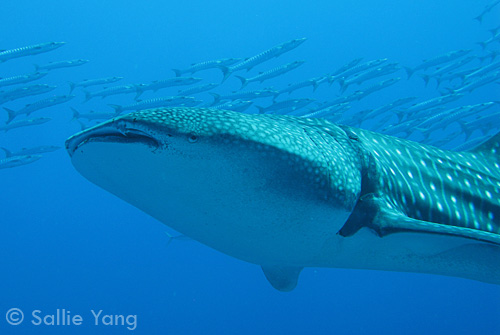
Sallie's whale shark, with barracudas in the background for bonus points
At meal time, Sallie sat next to Craig, showing Craig pictures on her camera, innocently(?) asking him to help her figure out what she had seen during the day (i.e., Sallie batting eyelashes at Craig in feigned damsel-in-distress manner).
She started with a genuine puzzle, the shadow of what appeared to be a hammerhead shark in the deep. She moved on to several other fish; then showed him a series of whale shark photos, starting with one taken at a distance, gradually getting closer and closer.
If you’ve read my posts about Craig over the years, it should perhaps come as no surprise that he fell hook, line, and sinker for the “Help me, Obi-wan; you’re my only hope” performance that Sallie put on. (The fact that she’s a lawyer and devious by nature certainly didn’t hurt.) She played the part to perfection, luring Craig directly into an immaculately choreographed trap.
Seated across from Craig and Sallie, I got up and started to video Craig’s reaction when Sallie showed him the whale shark photos. Greg recorded Craig’s reaction from another angle.
Demonstrating the mental acuity for which he and Elmer Fudd are renowned, Craig immediately became suspicious. He was perhaps already inclined to doubt Sallie’s whale shark sighting, but seeing me stand up to video his reaction prompted Craig to undertake critical analysis of the situation at hand:
“Hmmm, Sallie is showing me whale shark photos; but I didn’t see a whale shark; and Tony and Greg are video-ing me,” he thought.
“This can’t be good.” (pause for brain to process).
“Wait a second.” (pause while pained expression crosses his face).
“Tony obviously wants to see me react to Sallie’s photos. He must be setting me up.” (pause for Eureka!-moment expression).
“Aha! Tony probably gave her photos from somewhere else to put on her camera, which means there was no whale shark.” (pause for brain to rest and recover from prolonged exertion).
“Well, I’ll show him who’s smarter!” (pause for look of smug determination to appear on his face).
And so it was that Craig opened his mouth (as planned) and stuck his foot in it (once again, as planned), while I recorded the moment for all to savour:
What Craig didn’t count on, of course, is that I set him up to anticipate the set up, thereby resulting in his being set up even though he deduced that a set up was in progress and concluded (in error) that he had foreseen and hence averted said set up. Nice set up, no?
In all fairness, I couldn’t have pulled this one off without Sallie’s deft manipulation of Craig’s ego, which just goes to show you that sharks are definitely not the most dangerous animals in the sea.
Links to Sallie's video of the whale shark: Video 1; Video 2
Equipment Note
I started using a KISS rebreather back in 2004 with Craig, during my initial visit to the Eastern Fields. The rebreather units themselves haven’t changed much since then, but there have been some notable improvements in peripherals, two of which I think worth highlighting.
First is the Shearwater Predator dive computer. I don’t usually get excited by dive computers, but this one is perfect for diving with KISS rebreathers.
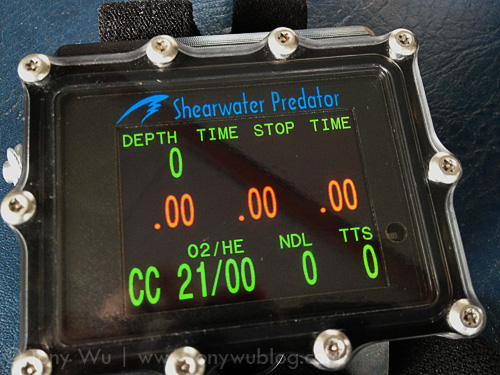
Shearwater Predator dive computer (before hooking up to O2 sensors)
The Shearwater computer can integrate directly to the O2 sensors on KISS units, thus eliminating the need for bulky, clunky O2 gauges we used previously. Moreover, the computer’s colour-coded OLED readout is dead-simple to understand:
Green = all good.
Red = problem.
Yellow = maybe problem.
Orange = slightly more of a maybe problem.
The display automatically adjusts brightness based on ambient light, and the interface is intuitive. The only minor issue I’ve experienced is that it’s difficult to take the battery out, as the compartment is snug, and there’s no tab or tool that makes it easy to yank the power source out when it needs replacing. Not a huge problem, but seems like one the manufacturer could address easily.
Bottom line though...I can’t imagine diving a KISS unit without the Shearwater Predator now.
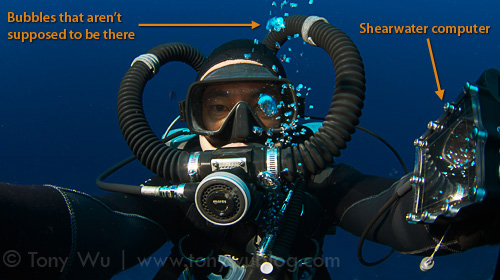
Me using the Shearwater computer. The bubbles are from a leak. Doh.
Second is the Nautilus Lifeline. When you’re on a rebreather, you don’t give off many bubbles. Plus, if you’re like me, there’s a tendency to stay down longer than divers using scuba tanks (mild understatement), so it’s tough for spotters on the surface to keep track of you.
This is a particularly relevant issue on Golden Dawn trips, since Craig’s itineraries tend to be to remote areas, many in open ocean with the potential for strong, unpredictable currents.
Safety sausages are the usual precaution against getting lost, but they can be cumbersome to carry and unwieldy to deploy/ put away. In some cases (especially with relatively compact safety sausages), they can be easy to miss in bright light or bad weather.
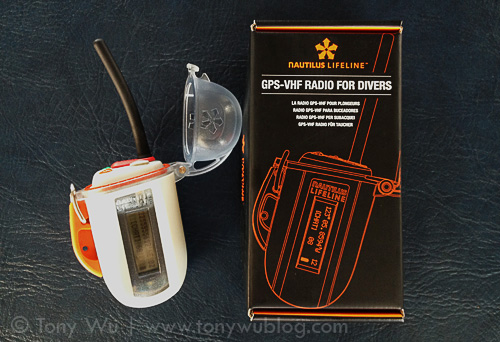
Nautilus lifeline
The Nautilus Lifeline incorporates GPS capability and a VHF radio, so you can (a) communicate with your dive boat (or any other nearby vessel with a radio for that matter) if you surface and no one is around, (b) tell them your exact GPS location, and (c) broadcast an emergency distress signal if you find yourself in a real bind.
Like the Shearwater, the Nautilus employs colour-coding:
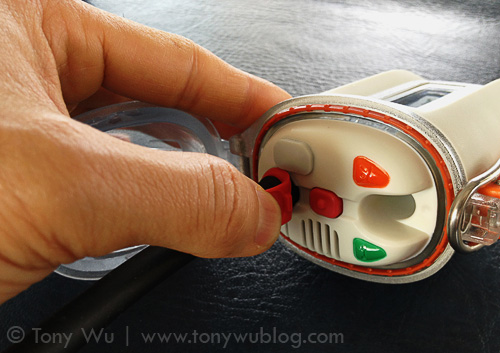
Nautilus lifeline: Green to chat;
Orange to hail on Ch. 16; Red to broadcast GPS position.
It’s an electronic gadget, so you have to keep it charged, and having one doesn’t preclude carrying a safety sausage as well, but the Nautilus Lifeline seems like an ideal fit for rebreather divers. It’s probably a good idea for normal scuba diving as well.
If you’re contemplating a trip on Golden Dawn and plan to dive with a rebreather, Craig has a couple of Shearwater computers and Nautilus units aboard for rental.

Jenny (foreground) and Frederick (background) trained on rebreathers this trip
The Alchemy Challenge
Meet Megamouth, a drab, nondescript sponge I came across at a dive site called Tokyo Express:
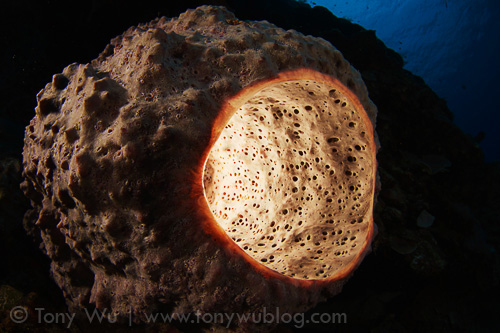
Megamouth: Steadfast solitary sentinel of the sea
It was so dull that I’m almost certain no one else gave it a second glance during the dive. Among colourful sea fans, resplendent soft corals and glittering tropical fish, it was a lump. A lone, unappreciated lump with no lump-friends nearby, and no polychromatic costume to induce the adulation of camera-toting divers.
Paradoxically, the sponge’s intrinsic lack of charisma attracted me to it. I found myself drawn to the pigment-challenged poriferan, unable to resist staring, feeling something akin to compassion for the aesthetically uninspiring organism before me.
I stared and stared, first from one side, then the other; from above, then below; and finally, after perhaps five minutes or so, I decided to photograph it. A while later, I ended up with one of my favourite images from the trip, depicting the lackluster sponge in the best possible light (please forgive the pun).
Emphasising the sponge’s characteristic “mouth” and its position on a ledge with nothing else around, I used the curvature of the reef and just a tinge of deep blue to impart the somber mood of a tireless, solitary sentinel standing watch over Poseidon’s realm.
In hindsight, I probably should have taken a normal photo at normal exposure of the same area and subject, to give you a better appreciation of how utterly uninteresting the sponge looked, but I wasn’t thinking about writing this text at the time.
Anyway, here’s a photo challenge for you: The next time you’re on a dive trip, see if you can create an inspiring, visually pleasing image of a ho-hum subject, something most people would pass by without a second thought.
It’s not easy, and it can certainly be frustrating trying to turn lead into gold, so to speak, but it can also be exceptionally rewarding when you succeed.
Transforming the mundane into something inspiring…photographic alchemy, so to speak…will hone your photography skills, and more importantly, your imagination and creativity.
Manta, Manta
For some reason, PNG and manta rays don’t mix for me. I’ve been to the manta cleaning station at Gona Balubalu in Milne Bay three times, where, despite assurances that “Mantas are virtually guaranteed,” I’ve never seen one there. All I’ve ever done is sit at the rock and twiddle my thumbs. I have, in fact, become quite adept at it.
In the Eastern Fields, the site that vexes me is Mantchuria, where there are inevitably multiple mantas “last week” and “the charter after you”, but never when I’m there. Sigh.
Well, as of the first itinerary of this trip, I’ve finally broken the string of manta ray no-shows. I saw one manta.
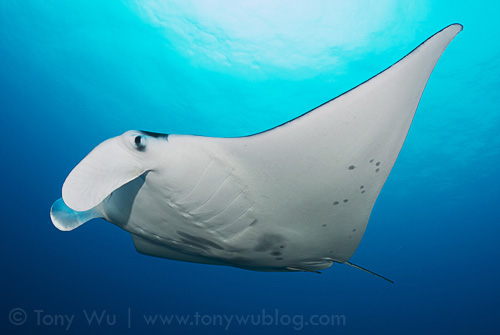
The only manta I've ever seen in PNG
Other people on the trip saw more (figures, doesn’t it?), but I’m resigned to my fate, so it’s not a big deal.
The main reason I bring up the topic of mantas is that we had a repeat encounter with one. On 14 January, several of our divers photographed a relatively friendly female at Mantchuria; four days later, we bumped into her again at Carl’s Ultimate.
The two sites aren’t an enormous distance apart, but still...it’s cool that several people on the trip had the presence of mind to make the connection between the two sightings.
The ray in question was recognisable from a missing chunk of her body and unique marks on her belly as well.
I, of course, didn’t see her on either occasion, but Adam in particular was lucky enough to have the manta approach while we were at Carl’s Ultimate, go underneath and flip belly-up to him, then swim along for an extended period. Adam was all grins when he surfaced. Quite understandable given his unforgettable interspecies interlude.
Wrap-Up
There were, of course, many more notable experiences and adventures during the trip. It’s impossible to write about everything that happened; the best I can hope to do is convey a sense of how much fun we had (a lot!), and how terrific the company was on both trips.
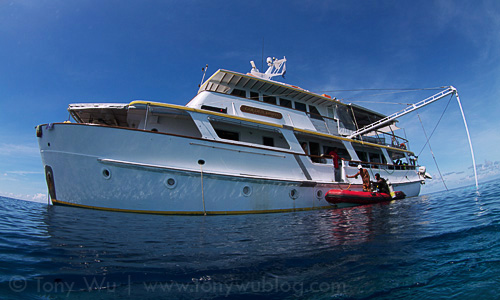
My home for the past month: MV Golden Dawn
I’m grateful as ever to the brave and foolhardy people who volunteered to be trapped on a boat with me for an extended period of time: Franck and Beck, Thomas, Adam, Sallie, Frederick and Gina, Jenny, Dan and Kozy, Colin and Nana, Sue, Bart and LeAnne; with special commendation to Jim and Greg, who each deserve a medal for surviving two back-to-back trips(!) with me; and last but certainly not least, my good friend Eric, who has been busy working a real job and was unfortunately feeling a bit under the weather during much of the trip.
In addition, I am indebted to a number of parties for their help and cooperation to make this trip a success: Captain Craig, master and commander of MV Golden Dawn; my friends at Wetpixel; Dan Baldocchi (thanks for coordinating the logistics!); Zillion; Aquaforum; PNG Japan; and Air Niugini.
Craig and I are plotting more adventures soon (he’s such a glutton for punishment), including the possibility of a very special rebreather-only trip to explore the twilight zone of the Eastern Fields (deeper waters, from 40m on down); an exploratory cruise to check out the southern reefs of the Louisiade archipelago, areas of which we believe few (if any) people have ever dived; as well as more exploratory trips.
If you’d like to get an early heads-up for one-of-a-kind adventures like these, please sign up for my trip newsletter.
Thanks for reading!
PS: If you’re planning a trip to PNG and are flying with Air Niugini, take note of the company’s baggage policy for divers: Air Niugini offers the following baggage allowance for scuba divers; International flights - 20kgs (44lbs) plus an additional 15kgs (33lbs) per person. Domestic flights - 16kgs (35lbs) plus an additional 15kgs (33lbs) per person. Air Niugini honours the International allowance for International passengers in direct transit on same day to a domestic port in PNG.
PS for the gang on the 2nd trip: It’s called an airboat or fanboat.

Sea fans and soft coral at Northern Passage
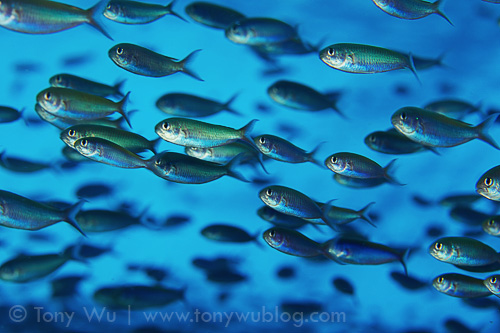
March of the Damselfish, Carl's Ultimate dive site
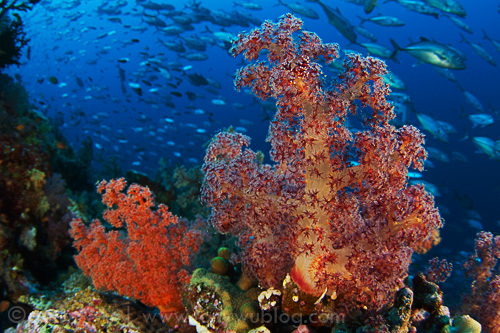
Soft coral with curtain of bigeye trevallies in background
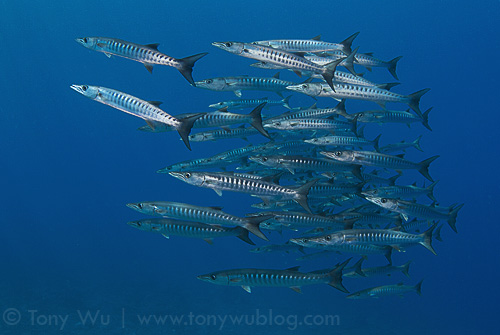
Small school (more like a classroom) of barracudas
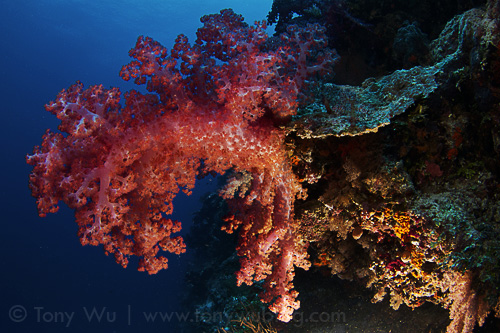
More soft coral at Jellybean Corners